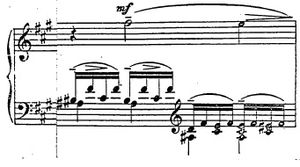
The Prelude in F-sharp minor, Op. 23, No. 1 is a composition by Sergei Rachmaninoff completed and premiered in 1903.[1][2] It is one of ten preludes composed by Rachmaninoff in 1901 and 1903.
Structure
[edit]The prelude is ternary and homophonic in nature. The "A" section (measures 1–13) introduces the first theme, section "B" (13–30) introduces a new set of variations, and measures 30–41 mark an altered return to the original "A" theme. Each of the larger ternary sections contains its set of "micro-variations" marked by changes in note values, dynamics, and rhythm. For instance, the "A" theme, introduced in measures 1 and 2, is varied in measure 8.
The Prelude proceeds from F-sharp minor to the relative major (A major) in measure 13, and returns to the tonic in measure 30.
A "hidden" chromatic sequence in the "A" section occurs in the bass line on the second beat of measure 1 and the first beat of measures 2–6. This sequence is later revealed as the basis for the "B" theme, first introduced transitorily as a modulation between the "A" and "B" sections. Compare measures 6 and 24:
References
[edit]- ^ Norris, Geoffrey, Rachmaninoff, Schirmer Books, 1993 (pg. 170).
- ^ Id.




Well, that’s interesting to know that Psilotum nudum are known as whisk ferns. Psilotum nudum is the commoner species of the two. While the P. flaccidum is a rare species and is found in the tropical islands. Both the species are usually epiphytic in habit and grow upon tree ferns. These species may also be terrestrial and grow in humus or in the crevices of the rocks.
View the detailed Guide of Psilotum nudum: Detailed Study Of Psilotum Nudum (Whisk Fern), Classification, Anatomy, Reproduction